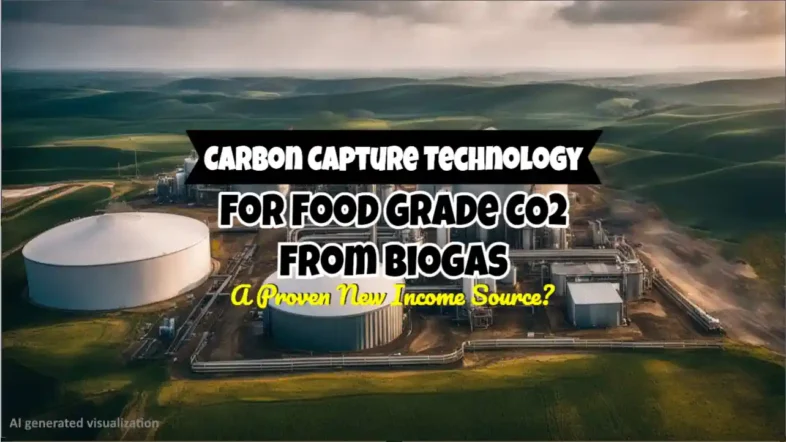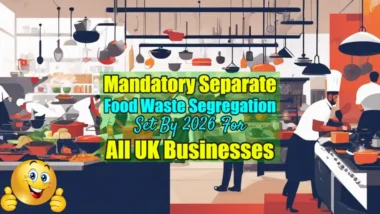In this article, we make the case for carbon capture technology for biogenic food grade CO2 (from biogas via biomethane upgrading) as a proven additional income source for AD plant operators.
Most new biogas plants are constructed with biomethane upgrading from day 1 of operation, meaning the purified methane process inevitably also provides reliable carbon dioxide output that until now has been vented to the atmosphere.
However, there is growing evidence that the technology now available is such that carbon capture technology for the production of food-grade CO2 from biogas is now a proven technology.
Therefore, is it now time for all biogas plant operators that produce biomethane to cease venting CO2 and also implement CO2 capture as a new income source?
Many industries, including food and drink manufacturers, face challenges in reducing their carbon emissions and are seeking means by which they can progressively reduce corporate emissions.
One important fact is that carbon capture technology can effectively lower these emissions by capturing carbon dioxide from biogas.
This blog will discuss case studies where this technology has provided food-grade CO2, offering solutions to a common problem in sourcing renewable CO2. Keep reading to discover how this could also become a new income source for the anaerobic digestion industry.
Key Takeaways
- Biogas plant operators Apsley Farms, and Crofthead Biogas in the UK, Strandmøllen A/S in Denmark and Bright Renewables internationally are leading the way with innovative carbon capture technology. They turn biogas into food-grade CO2, showing how this method can be both sustainable and profitable.
- Advanced processes to clean biogas help reduce greenhouse gas emissions by capturing carbon dioxide efficiently. This makes energy production more eco-friendly while creating high-quality CO2 for industries.
- Government policies and incentives in many countries support the growth of biogas upgrading and carbon capture technology. These measures encourage investment, innovation, and adoption of these green solutions.
- Utilising captured CO2 from biogas not only cuts down on emissions but also taps into a growing market for sustainable, food-grade CO2. This creates new opportunities in renewable energy sectors.
- Continuous research and collaboration among industry stakeholders are vital for advancing this technology further. It aims at creating a more sustainable future with reduced reliance on fossil fuels through renewable sources like biogas.
- However, the technology is proven and can become a viable additional income stream for biogas plant operators, while fulfilling the growing need for businesses to find ways to comply with their corporate pledged year-on-year decarbonisation targets.
- It’s time for the food and drinks industry to overcome their initial caution about a possible “yuck factor” from imagined fears that consumers might be put off by “fizz from manure.”
For any companies that need help understanding this new technology, such as:
-
- how to integrate it effectively into their biogas facility, or
- advice on how the use of renewable CO2 can provide effective corporate offsetting of their climate change emissions
- how to use life cycle assessment of a product (LCA) to assess its environmental benefit.
There are experts at SLR Consulting who will be able to assist Contact SLR Consulting here,
Biogas Upgrading and Carbon Capture Technology
There is no biogenic CO2 without first installing the equipment for biogas upgrading because the renewable carbon dioxide needed is a by-product of the upgrading process.

Biogas upgrading involves advanced processes to purify biogas, separating the CO2 from the methane (CH4) in biogas.
Capturing carbon dioxide from biogas, and using it to replace non-renewable sources is the next step in reducing greenhouse gas emissions, and producing sustainable food-grade CO2 for adding fizz to beverages, and, to a lesser extent, as a preservative in packaging is a major market.
Overview of the biogas upgrading process
Biogas upgrading technologies play a crucial role in enhancing the energy content of raw biogas. These technologies separate CO2 from methane to produce biomethane with high purity and include, in descending order of their popularity to date, the following processes:
- Water Scrubbing
- Pressure Swing Adsorption (PSA)
- Membrane Separation
- Chemical Scrubbing
- Cryogenic Separation
The cryogenic separation process is favoured for food-grade CO2, and involves several steps, including compression, cooling, and cleaning the biogas before separating the gases.
This upgraded biomethane is used as a renewable fuel source, contributing to sustainable energy production.
Capturing and using the carbon dioxide (CO2) byproduct from the upgrading process is equally vital. What has been routinely vented into the atmosphere should now be quality-controlled and used. Known as biogenic CO2, it adds value by transforming CO2 into food-grade quality for various industries. Adopting advanced techniques for capturing and separating CO2 ensures its success in significantly reducing carbon emissions.
Moving on, understanding the importance of this captured CO2 highlights how essential it is for both environmental benefits and industrial applications.
The importance of capturing and utilising carbon dioxide from biogas
Capturing and utilising carbon dioxide from biogas is crucial for reducing global carbon emissions to meet forthcoming net-zero targets. This technology is market-ready and has proven effective in enhancing the sustainability of energy production.
Moreover, it plays a significant role in minimising the climate impact of CO2 emissions from biogas plants, leading to regenerative farming. By separating CO2 from raw biogas, the carbon capture process contributes to creating more sustainable agriculture, and by generating food-grade sustainable CO2 the industry will also reduce dependence on imports and raise food security.
The utilisation of biogenic CO2 is also conducive to addressing the complexities surrounding climate impacts and demonstrates an avenue to reduce carbon emissions for other industries to follow.
Case Studies of Successful CO2 Capture from Biogas
The next section explores four examples of the successful application of carbon capture technology within the biogas industry, shedding light on its broader impact and potential for growth.

Apsley Farms
Apsley Farms specializes in an innovative approach to CO2 production through the anaerobic digestion process. By utilizing organic waste materials, such as crops and food waste, Apsley Farms converts these inputs into biogas.
This biogas is then purified, separating methane for energy production and capturing high-purity CO2.
The captured CO2, being food-grade, finds applications in various industries, including beverage carbonation and greenhouse agriculture, showcasing a sustainable model of recycling and reusing waste to produce valuable resources.
This process not only generates renewable energy but also contributes to carbon capture efforts, positioning Apsley Farms at the forefront of sustainable agricultural practices and circular economy initiatives.
Crofthead Biogas
Crofthead Biogas, located in Dumfries and Galloway, Scotland, is an innovative facility that processes up to 100,000 tonnes of slurries, cattle manure, energy crops, and dairy residues annually. This facility generates 8MWh of electrical power equivalent gas through anaerobic digestion.
A significant aspect of its operation is the focus on sustainability, highlighted by its accreditation for the new biomethane Renewable Heat Incentive (RHI) tariff and benefiting from the government’s Feed-in Tariff (FIT) program. This initiative supports renewable energy projects in the UK, contributing to carbon savings of 1,594 tonnes CO2e.
One of Crofthead’s remarkable achievements is its contribution to the carbon capture and utilization sector. The facility captures CO2 post-biomethane upgrade and converts it into dry ice, a critical commodity across various industries, including pharmaceuticals and food.
This makes Crofthead Scotland’s only dry ice manufacturing plant, further helping it advance toward its net zero goals. The CO2 capture rate at Crofthead is 36 tons per day, highlighting its substantial impact on carbon capture and utilization.
This operational model demonstrates a successful integration of renewable energy production with carbon capture technology, underlining the role of such facilities in achieving broader environmental and sustainability targets.
Crofthead’s approach not only generates renewable energy but also addresses CO2 emissions, offering a dual benefit of energy production and environmental protection.
The Scottish Environment Protection Agency (SEPA) has issued a permit for this CO₂ Recovery & Dry Ice Production Facility, allowing the operation of this innovative installation that purifies, liquefies, and sublimates CO2 vented from biogas to biomethane conversion into dry ice.
Strandmøllen A/S in Denmark:
Strandmøllen A/S in Denmark successfully produces food-grade CO2 from a biogas plant, showcasing the potential of this technology for sustainable energy production.
The company’s innovative approach to biogas upgrading and carbon capture has significantly reduced greenhouse gas emissions while also creating a new avenue for utilising a natural residual product.
This case study has demonstrated the viability of capturing CO2 from biogas for both environmental and economic benefits, paving the way for similar advancements in renewable energy technology.
Bright Renewables: renewable gas systems and carbon capture technology
Bright Renewables has developed innovative renewable gas systems and carbon capture technology. Their approach aligns with the quest for sustainable energy production and reduction of greenhouse gas emissions.
With a focus on methane purification, Bright Renewables’ advanced techniques ensure efficient separation of CO2 from raw biogas, delivering high-energy content biomethane flow. This progress is underpinned by ongoing research in carbon capture and utilisation technology, offering a significant impact on reducing carbon emissions.
The sustainable CO2 market benefits from the work on all four example projects above, reducing dependence on imports while creating a more environmentally friendly energy market.
Benefits of Biogas Upgrading and Carbon Capture Technology
Biogas upgrading and carbon capture technology offers:
- sustainable energy production,
- reduced greenhouse gas emissions due to ceasing a significant CO2 release from the anaerobic digestion process, and
- the utilisation of a natural byproduct of pure renewable methane production.

Biomass with CO2 capture and storage (Bio-CCS) has shown the potential to capture at least 90% of CO2 emissions from large stationary sources, presenting an innovative avenue towards sustainable energy production.
Carbon capture technology helps achieve a low-carbon future, making a significant impact on reducing carbon emissions from large stationary sources.
Now read on and learn more about how advancements like our food grade CO2 from biogas technology are shaping the future of renewable energy.
Policy Analysis and Future Outlook
Government policies drive biogas upgrading and carbon capture technology adoption. With incentives to promote renewable energy sources, the market for food grade CO2 from biogas is growing.
Biogas will play a significant role in achieving a low-carbon future.
The current market for food-grade CO2 and the potential for growth
The demand for food-grade CO2 is increasing, creating a promising market with substantial growth potential. The production of sustainable CO2 from biogas offers opportunities to reduce carbon emissions while meeting the rising need for food-grade CO2 from biogas.
Developing practical strategies for harnessing this potential will be essential in steering the industry towards a sustainable and low-carbon future. As biogas plant developers, owners, and operators, it’s crucial to focus on leveraging these opportunities for sustainable development and long-term growth.

Government policies and incentives for promoting biogas upgrading and carbon capture
Government policies and incentives play a crucial role in promoting biogas upgrading and carbon capture to produce food grade CO2 from biogas. Here are some key aspects to consider:
- Financial Incentives: Governments offer subsidies and grants to support the implementation of carbon capture technology, making it an economically viable option for biogas plant developers.
- Regulatory Support: Clear and stable regulations governing the production and utilisation of food-grade CO2 from biogas provide a conducive environment for investment and innovation.
- Carbon Pricing Mechanisms: The introduction of carbon pricing schemes creates a financial incentive for reducing emissions, encouraging biogas plant owners to invest in carbon capture technology.
- Research Funding: Government-funded research initiatives drive innovation in biogas upgrading and carbon capture technology, leading to continuous improvements.
- Market Access Initiatives: Policies that facilitate access to markets for sustainable CO2 products incentivise the production of food-grade CO2 from biogas, spurring market growth.
- Education and Awareness Campaigns: Governments promote awareness among stakeholders about the benefits and opportunities associated with biogas upgrading and carbon capture technologies through targeted campaigns.
- Emission Reduction Targets: Setting ambitious emission reduction targets encourages the adoption of carbon capture technology as part of national climate action plans.
- Collaboration Platforms: Governments create platforms for collaboration between industry stakeholders, researchers, and policymakers to drive collective efforts towards advancing biogas upgrading and carbon capture for food grade CO2 from biogas.

Concluding – Food Grade CO2 from Biogas
Biogas upgrading and carbon capture technology have shown potential for reducing carbon emissions. Successful case studies like those provided in this article for Apsley Farm Biogas, Strandmøllen A/S in Denmark and Bright Renewables demonstrate the viability of producing food-grade CO2 from biogas plants.
The benefits of this technology include sustainable energy production, reduced greenhouse gas emissions, and the utilisation of a natural residual product – paving the way towards a low-carbon future.
Government policies and incentives will help greatly in promoting biogas upgrading and carbon capture technology to ensure its widespread adoption in achieving climate change reduction goals.
Food Grade CO2 from Biogas – FAQs
1. What is carbon capture technology for food-grade CO2 from biogas?
Carbon capture technology takes food grade CO2 from biogas that has been upgraded to very pure methane (biomethane), such as the gas from food waste treatment, and turns it into clean CO2 that’s safe to use in foods.
2. How does anaerobic digestion work in producing biomethane?
Anaerobic digestion breaks down organic material without oxygen, creating methane. This process helps in both methane purification and biomethane production.
3. Can this technology help reduce greenhouse gases?
Yes, by capturing carbon dioxide before it escapes into the air and using it or storing it safely, we can cut down on greenhouse gases.
4. Is the captured CO2 really good enough for food?
Absolutely! The process ensures that the captured CO2 is pure and meets all standards for food-grade CO production.
5. Does this method also produce energy?
Indeed, converting biogas to biomethane through anaerobic digestion not only captures CO2 but also creates carbon-negative energy since more harmful gases are removed than emitted.





